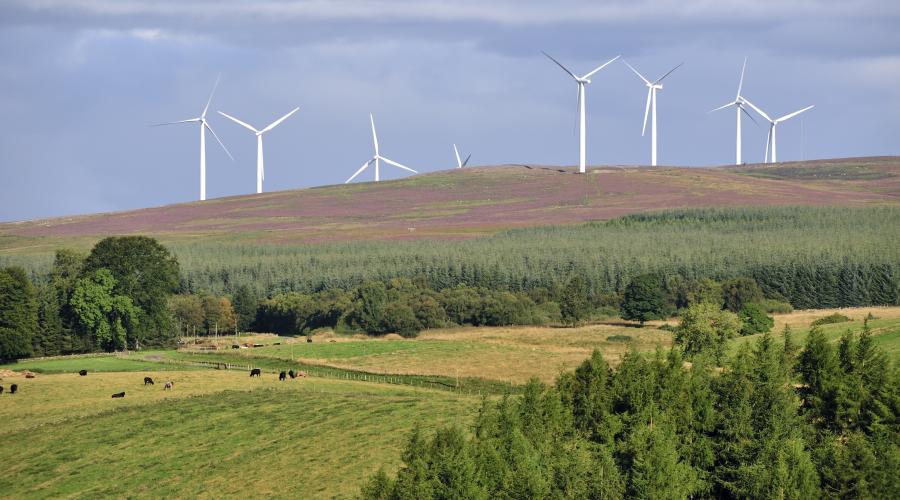
Wind farm impacts on birds
Careful siting and design of wind farm development can avoid significant impacts on birds
Well-sited wind farms have limited effects on birds and our role is to guide development to the best locations. We also advise on assessing the effects and the guidance below provides further information for a range of effects and species.
Our standing advice for planning consultations provides general advice for avoiding or minimising impacts on birds.
More specifically wind farms present three main potential risk to birds:
- death through collision or interaction with turbine blades
- direct habitat loss through wind farm construction
- displacement through indirect loss of habitat if disturbance causes birds to avoid the wind farm and surrounds
Displacement can include barrier effects in which birds are deterred from using their normal routes to feeding or roosting grounds.
You should consider each of the three types of risk above for every bird species that uses the site.
How birds behave close to wind turbines still isn’t well understood. Monitoring information on bird behaviour and collisions is available for some species, however.
Collision risk modelling
To measure collision risk, you should first assess how many collisions would occur in theory were birds to take no avoiding action. This should consider flight activity, bird size and speed, and turbine size and speed.
Next, you should apply an avoidance factor to reflect how, in practice, birds often manage to avoid a turbine blade. They may change their route, time their flight through the rotor or take emergency avoidance action.
Find out about:
- Calculating a theoretical collision risk assuming no avoiding action
- Calculating the probability of collision - example spreadsheet
- Use of Avoidance Rates in the NatureScot Wind Farm Collision Risk Model
- Flight Speeds and Biometrics for Collision Risk Modelling
Species-specific guidance
We regularly review avoidance rates and guidance for individual species.
View species-specific guidance:
We’ve also reviewed the need to conduct collision risk modelling for pink-footed geese in support of wind farm applications. In light of the robust population and its high avoidance rate of 99.8%, collision risk modelling for pink-footed geese is only required if a proposal has connectivity with a protected area where this species is a qualifying interest.
Read more in:
How to assess wider impacts
To help assess the significance of impacts of developments on birds in the wider countryside, view Natural Heritage Zone population estimates for 28 species of interest. These are available to view within the Natural Heritage Zone Bird Population Estimates: SWBSG Commissioned Report No.1504.
You may also find useful: Assessing significance of impacts from onshore windfarms on birds outwith designated areas.
Artificial light is known to have many effects on birds which may be positive (increased opportunity for activity that would normally only occur during daylight); and negative effects, including attraction to lights (phototaxis), disruption of photoperiodicity and increased opportunities for visually active predators.
You can also read the following Information Note: The Effect of Aviation Obstruction Lighting on Birds at Wind Turbines, Communication Towers and Other Structures.
How to assess impacts on Special Protection Areas
NatureScot has produced guidance to help you identify ‘connectivity’ between development proposals and Special Protection Areas: Assessing Connectivity with Special Protection Areas (SPAs) – includes dispersal and foraging distances for a range of bird species
Further guidance
Monitoring methods
- Monitoring the impact of onshore wind farms on birds
- Guidance on Methods for Monitoring Bird Populations at Onshore Wind Farms
Survey methods
- Recommended bird survey methods to inform impact assessment of onshore wind farms
- Breeding seasons for Scotland’s birds
- Capercaillie Survey Methods
Assessment methods
- A Review of Disturbance Distances in Selected Bird Species
- Environmental Statements and Annexes of Environmentally Sensitive Bird Information: Guidance for Developers, Consultants and Consultees
- Assessing the cumulative impacts of onshore wind farms on birds
Mitigation measures
- Assessment and mitigation of impacts of power lines and guyed meteorological masts on birds
- Dealing with construction and birds
- Wind farm proposals on afforested sites – advice on reducing suitability for hen harrier, merlin and short-eared owl
- Implications of additional protection for hen harrier, red kite and golden eagle under Schedules A1 & 1A of the Wildlife and Countryside Act (1981)
- The use of helicopters and aircraft in relation to disturbance risks to Schedule 1 & 1A raptors and wider Schedule 1 species
Draft NatureScot/British Wind Energy Association guidance
We do not support the use of the NatureScot/BWEA draft guidance Assessing impacts of Wind Farms on Birds or any updates based on it. We didn’t finalise this draft guidance, as we weren’t satisfied that the approach complied with the Habitats Regulations 1994.
Contact
To report a bird collision with a wind turbine, fill in our bird collision reporting form. You should email your completed form on this email.





